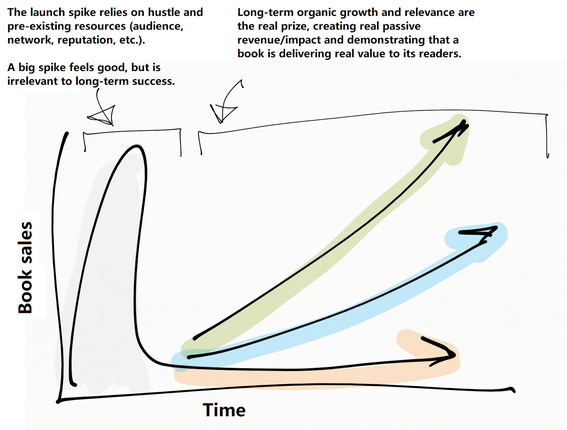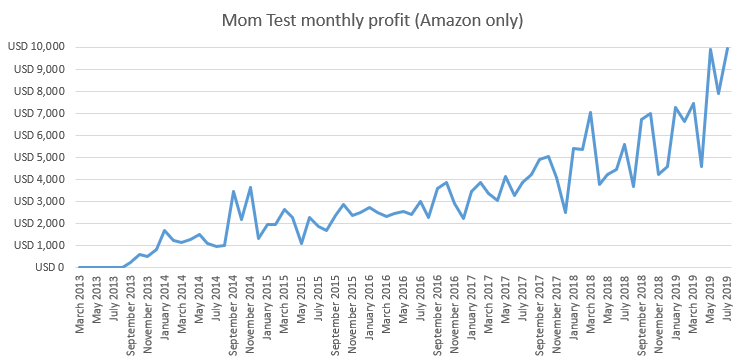Word of mouth can carry nonfiction to success in two wildly different ways.

The first is elemental, unpredictable, and temporary. It requires catching — and successfully riding — the turbulent wave of public sentiment and PR.
The second is reliable, predictable, and long-lasting. But it’s slower to get started and requires rethinking how your book fits into readers’ lives, as well as the job it is promising to accomplish for them.
From Write Useful Books:
Authors tend to think of reader recommendations as a bit of a mystery. Or even worse, as a hope.
But you don’t *hope* for recommendations; you *design* for them.
What distinguishes between these two categories of word of mouth?
The first — riding a PR wave — is the enviable situation where everyone is suddenly talking about your book, which causes everybody else to start wonder what they’re missing. In fiction, this happened for Fifty Shades. In nonfiction, it happened for Lean In and Why We Sleep. Each of these books sold an incredible number of copies during their moment in the spotlight.
But when’s the last time you heard anyone mention any of the above titles?
You probably already understand the power and peril of riding the PR wave; it’s a high-risk, high-reward, all-or-nothing approach that leaves most authors dashed against the cliffs of obscurity while lifting a rarefied few to the heights of instant celebrity success.
But the second approach is less well known, and well-worth understanding. It’s slower to get started, but it endures, and it’s doable by anyone willing to invest the effort. I call it “designing a strong Recommendation Loop.”
Your book’s Recommendation Loop is triggered by someone having a problem (or question or goal), and mentioning that concern to someone else who already believes that your book is the answer. It functions both in-person and online, between both strangers and friends:

You may be feeling that this sounds just a little bit too good to be true. And if you’re viewing it as a “marketing tactic,” then you would be correct. It goes deeper than that. Allow me to explain.
Recommendation Loops are not a marketing tactic to be slapped onto any finished book to “make it viral.” Rather, this sort of organic growth is unlocked through thoughtful product design, beginning with your earliest decisions about what to write and who to write it for. If your manuscript is already written and edited, then you’ve already missed the opportunity to strengthen your Recommendation Loop. This is something you need to think about at the beginning, not the end.
But when properly designed for, the results are magical:

How to build a killer Recommendation Loop
This is neither fast nor easy, but it is reliably doable.
1 // Firstly, your book must make a clear promise about what it will accomplish for the reader. It should be delivering a result, not just ruminating on a broad topic.
“It’s about history” isn’t good enough.
That’s just a topic.
A strong promise requires going a step further to say:
“This book will help you understand history’s grandest failures so that you can make better decisions, suffer less uncertainty, and live a better life.”
This isn’t just a change to how you write your Amazon blurb. It’s a change to how you write your book.
Evergreen recommendations are triggered by the existence of a burning, must-solve problem, goal, question. If your book isn’t making a promise about what it will do for people, then it can’t be recommended as the solution.
2 // Secondly, your book must be the world’s best solution. Not for everyone, but for a certain type of person.
This means deciding who you are most able to serve and how you can best help them, and then focusing completely on that, to the exclusion of all other readers and topics.
“Deciding who to write for” sounds self-evident, but almost nobody truly does it, because they’re unwilling to make the hard call about who and what to leave out.
But making this one choice incorrectly will limit the potential of every other part of your book.
From Write Useful Books:
Consider how much a book on some topic would change if it was written for complete beginners vs. more experienced practitioners. Or for people who already believe in the goal vs. those needing to be educated and convinced that it’s worthwhile.
The naive non-solution is to attempt to include everything for all potential readers. But by doing so, you end up writing a book that is mediocre for everyone and mind-blowing for no one; every chapter that the amateur adores, the expert endures, and vice versa.
A tightly defined Reader Profile opens a path toward creating the best book in the world for some type of reader, with high value-per-page and zero fluff. And you need to be the best. Not for everyone, but for someone.
People only recommend the best available solution. If your book is scoped too broadly, being “fairly good” for everybody, then it will never get recommended. The only way to avoid being ignored by everyone is to be loved by some. And that requires having the courage to decide who it’s not for.
3 // Thirdly, before anyone can recommend your book, they need to have read it, loved it, and received massive value from it.
This requires:
- Front-loading the value, cutting the fluff to increase value-per-page, and designing a stronger and more engaging Reader Experience (Chapter 4)
- Iterating with real Beta Readers to verify that it actually works (Chapter 5)
- Doing enough hands-on marketing in the early days to find the happy “Seed Readers” who are able to begin recommending your book to those who need it (Chapter 6)
Wishing you the very best with your book-in-progress,
—Rob Fitzpatrick
 By
By